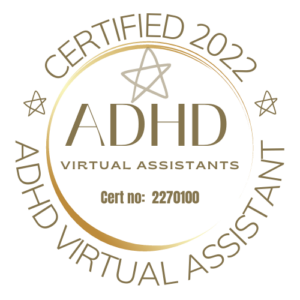Work can be a serious source of frustration for those with attention deficit disorder (ADD) or attention deficit hyperactivity disorder (ADHD). Trust me, I know. I spent years dropping the ball, forgetting meetings, and being disorganized. It can make a significant difference in your life to find effective coping strategies for areas of weakness, and can greatly impact and improve your work performance and overall happiness – not to mention reduce some of the stress! Here are a few tips and strategies that may help make your work life a little easier and more productive.
Overview
Why is the workplace so difficult for people with ADD/ADHD? Here is a list of the most common challenges that may cause a hindrance in your career success:
- Staying focused on tasks
- Tuning out distractions
- Disorganization
- Taking on multiple tasks and not finishing them
- Failure to meet deadlines
- Paying attention in long meetings
- Missing important details in conversations
- Boredom
- Forgetfulness
- Communicating with others in an effective way
- Feeling undervalued
Increase Productivity
Try these simple strategies for working with ADD/ADHD to see if any of them help you:
1. Avoid Multitasking
We all know that staying focused and on task is vital for getting work completed. This is often when some find that multitasking becomes an issue. Instead of focusing on a single task, one becomes distracted by multiple tasks, incoming calls, messages on social media – you name it. Unfortunately, that generally results in none of the tasks being done to completion.
When one’s mind begins to wander and is distracted, not only does work not get completed, but many individuals find that they end up working late or taking work home in order to get caught up. Generally, this creates more stress and less time for the much needed relaxation and rest that those of us with ADD/ADHD need in order to function properly. It also impedes on our home life, making it more difficult to keep a healthy work-life balance.
2. Time Blocking
Consider time-blocking on your calendar in order to get certain tasks done. Set your time blocks for reasonable amounts of time to avoid feeling like you’re torturing yourself. It’s easier knowing that you only have 30-45 minutes to work on a task before you can walk away, versus leaving it open-ended. Avoid starting the next task, checking your email, answering your phone or text messages, until you’ve spent the allotted time on the initial task. Allow yourself a 5-15 minute break in between task blocks to refresh your mind and allow for much needed mental downtime. Focusing for short bursts on one thing at a time, then moving on to something else, ensures variety and the opportunity to get up and move – both great ways to complete tasks without too much pain.
3. Manageable Chunks
By breaking down tasks into bite-sized pieces, it can help you feel less overwhelmed with all there is to do. When work feels insurmountable, procrastination can very quickly take over for those with ADD/ADHD, making it difficult to even get started on any task at all. Particularly when the task is something you have no interest in or requires a great deal of mental energy.
Breaking down your work into short bursts and then allowing yourself to walk away makes it feel significantly less daunting. If working in time blocks is not effective for you, try taking your task and breaking it down into multiple small achievable steps. Procrastination often feels like the way to solve the overwhelm in the moment, but that can leave you with unfinished tasks and missed deadlines.
4. Task Management System
Consider adopting a task management system, like Trello, ClickUp, or Teamwork. Inside these task management systems you can add individual tasks as well as set deadlines and priority. By adding all of your tasks into a tool like this, you remove the opportunity to forget. Make sure you have a mobile app version of the tool so you can add tasks to it while on the go.
In addition to helping you keep track of everything being asked of you, there is the satisfaction of marking tasks complete. You can even break the larger tasks down into the bite-sized pieces mentioned above, so as you mark each piece as completed, you can experience a sense of accomplishment. Often, that sense of accomplishment helps fuel the motivation to continue on when the timing is right.
5. Set a Timer
As old-fashioned as this might sound, for some it’s exactly the right strategy for completing things in more doable time periods. For some, setting a timer for 45 minutes of work followed by a 15-minute break can make it easier to get through the day. Shorter work periods and breaks may work better for others.
The trick is to be sure that the amount of time you allow for work is significant enough to complete a portion of the task. It’s also important that the break time in between task times is long enough to feel refreshed, but short enough to avoid getting involved in another activity.
6. Find An Accountability Partner
A supportive co-worker who understands your issues with staying on task can be a real asset when it comes to redirecting you. Some people have found that it has been helpful to share information about ADD/ADHD with their employers and together come up with simple accommodations to make work more successful.
In many situations, however, this has been an area to avoid. If you have a supportive coworker that you feel comfortable sharing this information with, as opposed to your employer, they may be willing to help with keeping you on task. Sometimes the simple fact that there is someone else there to hold you accountable is motivation enough to complete what you need to do.
7. Make A New “To Do” List Every Morning
Each morning, before you’ve started browsing email, social media, or the news, create a list of the things you want to accomplish that day. Try to keep your list realistic, so you’ll have a better chance of accomplishing everything. Arrange your list in order of importance, putting the most important tasks first. Assign each task a specific time of the day and cross each one off as you complete it. There is something just so satisfying about marking things off your list.
8. Make Organization a Daily Habit
This task starts at home. Don’t think of it as cleaning. Most of us hate cleaning, as much as we like the clean result. Instead, think of it as your organization plan.
- Any items you keep should have a home. Use filing cabinets, labels, clear storage boxes, and any other types of organizers.
- Spend 10 minutes each day to pick up and return items to their designated home.
- If you take it out, put it back.
- Keep a box for loose papers and other random items to be put away, then go through the box at the end of every day.
Starting your day with an organizational habit can lead to a more productive day at work. Once you’ve started something, it gets you into the right mindset. Starting your morning with organization for those with ADHD is vital for helping you continue with the practice throughout the day.
9. Use Electronic Reminders
Forgetting meetings, deadlines, medications, (our head), etc., can create problems both at work and in our personal lives. For help, turn to computer programs and other electronic devices like your phone to remind you of appointments and deadlines. For example, set your computer or smartphone to alert you 5 minutes before every event in your calendar.
For myself, I set reminders for 15 minutes out, then 10 minutes, and finally 5 minutes – at which point I start to prepare myself for the meeting or event. The most vital of those reminders is the 5 minute reminder as this keeps me from being reminded, but then distracted again.
10. Tune Out Distractions
There is nothing quite like a bunch of conversations and phone calls going on around us when we need to concentrate. It’s often virtually impossible to tune out all the business and distractions going on around us. Try these strategies to help:
- Route your calls to voicemail, then check it only at set times during the day.
- Ask for a quiet cubicle or office, so you aren’t distracted by others.
- Use a white noise machine or put on headphones to drown out the noise around you.
- Stick to doing just one task at a time.
If you’re running your own business, it can be even more difficult to stay organized without the normal accountability factor of a corporate job. Instead of being bogged down with the overwhelm and resulting frustration, consider a virtual assistant trained in helping those with ADHD. The Ambitious Assistant is a virtual assistant team specializing in organization, planning, and communication for ADHD entrepreneurs and we would love to help you get back to the aspects of your business that you enjoy.
Click here to schedule a FREE Discovery Call to see how we can help you.











